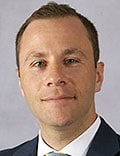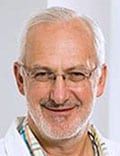Seventeen years ago, Philip Segal, a retired accountant from suburban Toronto, Canada, was diagnosed with prostate cancer in a private clinic. After rejecting brachytherapy recommended by an oncologist, he went on active surveillance to watch, but not treat, the Gleason 6 (grade group 1) tumor. As he approaches his 80th birthday later this year, Segal said he plans to maintain the status quo. "It definitely brings me some peace of mind. I'd rather do that than not follow it and kick myself if there was a serious change," he said.
Meanwhile, 2 years ago and 200 miles away in suburban Detroit, Bruno Barrey, a robotics engineer, was diagnosed with three cores of Gleason 6 and went on active surveillance.
Six months after the original diagnosis, however, Barrey, 57, underwent a follow-up biopsy. This time, all 16 cores were positive, with a mix of low-risk Gleason 6 and more advanced Gleason 3 + 4 lesions. His tumor was so large he underwent radiation therapy in 2023, ending his brief stint on the monitoring approach.
The two cases illustrate the complicated truth of active surveillance. For some men, the strategy can prove to be short-lived, perhaps 5 years or less , or a life-long approach lasting until the man dies from another cause.
Which kind of race a man will run depends on a wide range of factors: His comfort level living with a cancer, or at least a tumor that might well evolve into an aggressive malignancy, changes in his prostate-specific antigen (PSA) level and results of a magnetic resonance imaging test, the volume of his cancer, results of genetic testing of the patient himself and his lesion, and his urologist's philosophy about surveillance. Where a patient lives matters, too, because variations in surveillance levels exist in different geographic areas, domestically and internationally.
"Active surveillance is a strategy of monitoring until it is necessary to be treated. For some people, it is very short, and for others, essentially indefinite," said Michael Leapman, MD, clinical lead at Yale Cancer Center in New Haven, Connecticut. "While there are differences, I think they are mainly about who is the ideal patient."

Most studies show that roughly half of men in the United States who go on active surveillance abandon it within 5 years of diagnosis. Rashid Sayyid, MD, a clinical fellow at the University of Toronto, Canada, found in a paper presented to the American Urological Association in 2022 that the number leaving active surveillance increased to nearly two thirds at 10 years.
Peter Carroll, MD, a urologist at the University of California, San Francisco, and a pioneer in the active surveillance in the late 1990s, said the major reason men abandon the strategy is because monitoring reveals the presence of a more aggressive cancer, typically a grade group 2 (Gleason 3 + 4) lesion. But other reasons include anxiety and other emotional distress and upgrades in blood levels of PSA and increases in the rating scale for MRI for the likelihood of the presence of clinically significant prostate cancer.
Laurence Klotz, MD, of the University of Toronto, Toronto, Ontario, who coined the term active surveillance strategy in 1997 and published the first studies in the early 2000s, said it is important to consider when the data on surveillance were collected.

Since 2013, when MRI began to be adopted as a surveillance modality for men with prostate cancer, the dropout rate began declining. The reason? According to Klotz, MRIs and targeted biopsies result in greater accuracy in staging the disease, determining which patients need to be biopsied, which helps some men avoid being diagnosed to begin with.
Klotz cited as an example of the emerging change a 2020 study in the Journal of Urology, which found a 24% dropout rate for surveillance at 5 years, 36% at 10 years, and 42% at 15 years in a series of 2664 grade group 1 patients on active surveillance at Memorial Sloan Kettering Cancer Center in New York City from 2000 to 2017.
Leapman cited a 2023 study in JNCI Cancer Spectrum using the National Cancer Database that found a decline in the percentage of patients who had grade group 1 in biopsies from 45% in 2010 to 25% in 2019.
"There is more judicious use of PSA testing and biopsy in individuals who are more likely to have significant prostate cancer," Leapman told Medscape Medical News. "And MRI could also play a role by finding more high-grade cancers that would have otherwise been hidden."
The changing statistics of prostate cancer also may reflect decreases in screening in response to a 2012 statement from the US Preventive Services Task Force advising against PSA testing. The American Cancer Society in January 2023 said that statement could be driving more diagnoses of late-stage disease, which has been surging for the first time in two decades, especially among Black men.
Sayyid said patients must be selected carefully for active surveillance. And he said urologists should not promise their active surveillance patients that they will avoid treatment. "There are numerous factors at stake that influence the ultimate outcome," he said.
Progression of Gleason scores is estimated at 1%-2% per year, Sayyid added. When active surveillance fails in the short to medium term — 5-10 years — the reason usually is that higher-grade cancers with Gleason 3 + 4 or above were initially missed.
Sayyid said he counsels patients aged 70 years and older differently than those in their 50s, telling younger patients they are more likely to need treatment eventually than the older patients.
Factors that can affect the longevity of active surveillance include the presence or absence of germline mutations and the overall health and life expectancy and comorbidities such as heart disease and diabetes in a given patient, he said.
Urologists hold varying philosophies here, especially involving younger patients and the presence of any level of Gleason 4 cancer.
William Catalona, MD, of Northwestern University Feinberg School of Medicine in Chicago, Illinois, who developed the concept of mass screening with PSA testing, originally opposed active surveillance. In recent years, he has modified his views but still takes a more conservative approach.
"I consider active surveillance a foolish strategy or, at best, a short-term strategy for young, otherwise healthy men, especially those having any Gleason pattern 4 disease."
"More than half will ultimately convert to active treatment, some too late, and will require multiple treatments with multiple side effects. Some will develop metastases, and some will die of prostate cancer."
Sayyid takes a more liberal approach. "I would counsel an eligible patient considering active surveillance that at the current time, I see no strong reason why you should be subjected to treatment and the associated side effects," he said. "And as long as your overall disease 'state' [the combination of grade, volume, PSA, and imaging tests] remains relatively stable, there should be no reason for us to 'jump ship'. In my practice, another term for active surveillance is 'active partnership' — working together to decide if this is a sprint or a lifelong marathon."
Carroll reported research funding from the National Institutes of Health.
Howard Wolinsky is a Chicago-based medical freelance writer. He just observed his 13th year on active surveillance for low-risk prostate cancer, what he calls his "pros mitzvah." He is working on a Master of Public Health at the University of Illinois Chicago School of Public Health.



Comments